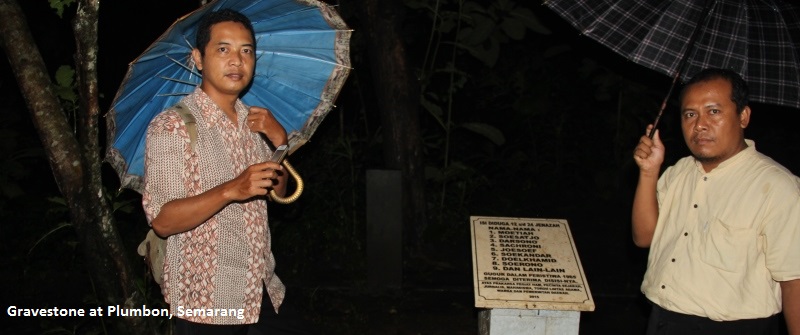
15 Mar Blog: Homemade monuments (2)
Indonesians have forgotten the genocidal violence of 1965. Or have they? In this town in Central Java, locals and officials recently gathered for a remarkable commemorative service to the 1965 dead. Gerry van Klinken investigates.
Every time I visit Indonesia, at least one encounter makes me question everything I know about this country. This time it happened one rainy night, in a muddy patch amidst dripping teak trees outside Semarang. The little brick column I saw there marks a mass grave dating to the anticommunist pogroms of 1965-66.
Like the crude homemade monument to the 1965 tragedy I discovered in a village in Flores, it was built by locals. But it is co-signed by the government, making this the first officially recognised commemorative marker to 1965. The Forestry Department reclassified this piece of forest as a “grave.” Bricks set into the earth mark its 5x10m border.
How could this happen? Thousands of mass graves exist around the archipelago. None are marked. The murderers intended that those in them be forgotten, excised unmourned from the human race. Spectators at public executions in 1965-66 were forced to clap for joy.
The murderers are still influential. In 2015, exactly 50 years later, several attempts to remember were repressed. Genocidal violence has nearly been erased from the collective memory.
And yet on 1 June 2015 (Pancasila’s birthday) around 500 people gathered in Mangkang for a relaxed commemorative service. In this amateur video, we see uniformed officials mixing with civilian residents. A saxophone moans. There is singing, crying, hugging, speeches. Flower petals are scattered.
The main organiser was the tall figure on the left in the photo. Yunantyo Adi S, or Mas YAS, is a Semarang journalist. He learned about the site through our Dutch colleague Martijn Eickhoff of NIOD (this has the story in Indonesian) .
Past attempts at commemoration failed, Mas YAS told me, because organisers did not talk to the authorities. Seven months before 1 June 2015, he started with the soldiers. He told his sceptical friends: “If we don’t ask them, they will hit us. If we do, they may hit us, or they may say go ahead. Talking creates chances.” He said to the local military commander: “Our objective is not political, but purely humanitarian.” Many visits followed to other military officers, to city administrators, to two militia groups that often disturb such events, and to religious leaders – Islamic, Catholic, Protestant. Then the Jakarta military high command (yes, it is that important!) wrote with a go-ahead. Religious figures told the local press it was time the dead be acknowledged and prayed for. Locals around the site agreed. When the day arrived, everyone was used to the idea that compassion is normal; hate is not.
Everything was done to focus on humanity and justice, not politics. The brick column was a “gravestone,” not a “monument.” The day was 1 June, not 30 September. A witness to the execution was found, and police took down a statement. Survivors imprisoned with those executed remembered some names. The National Human Rights Commission was urged to exhume the site forensically.
Victims’s relatives were the last to be invited. Organisers did not want the event to be seen as their demand for “revenge.” The woman with the brown headscarf in the video had spent her life looking for her step-father’s grave. She was overcome with emotion, and later had to be carried home.
National TV broadcast the event, noting this was just one of a huge number of such graves. The lesson, Mas YAS concluded as we sat drinking sweet coffee at a neighbour’s house nearby, was this: “If it can be done in Central Java, where the killings were so savage, it can be done anywhere.” As the rain poured off the roof, I realised how many of my beliefs about Indonesia were simply wrong. Including the belief that 1965 has been forgotten.
(Gerry van Klinken is a senior researcher at the KITLV, and professor of Southeast Asian history at the University of Amsterdam.)
Photo: Gravestone at Plumbon (formerly known as Mangkang), on the outskirts of Semarang. “This contains about 12 to 24 bodies,” it reads. “Fallen in the events of 1965. May they be received into His presence. An initiative of human rights activists, lovers of history, journalists, students, inter-religious leaders, local residents, and the city government. 2015.” Only eight names are known.




John Roosa
Posted at 22:57h, 17 MarchThanks so much for writing about this. Applause as well for Martin and Mas YAS. I read about this case in Historia and in some newspaper accounts. The patient humanitarian work of Mas YAS can serve as a paradigm for activists elsewhere in Indonesia. It deserves to be well known. The marking of the graves and sites of execution is a crucially important first step.